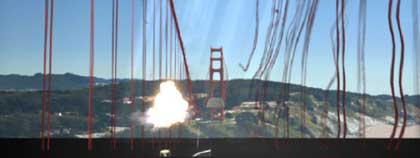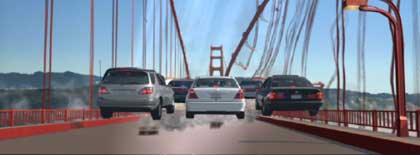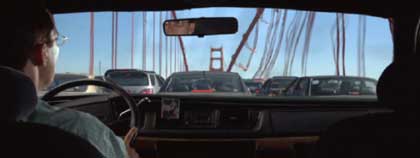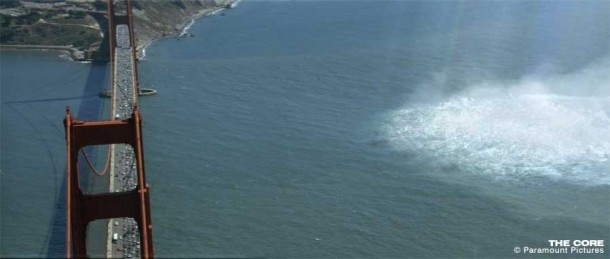Computer Cafe destroys the Golden Gate Bridge
Visual Effects Sequence for Paramount’s “The Core”
In the movie “The Core” from Paramount pictures, the center of the Earth has stopped rotating. The planet’s magnetic field and atmosphere are rapidly deteriorating. Unfiltered cosmic rays begin to boil San Francisco Bay and the superheated water flows under the Golden Gate Bridge melting automobile tires, exploding gasoline tanks, cracking the roadbed, snapping suspension cables and ultimately bringing down the bridge itself in a spectacular visual effects sequence created by ComputerCafé (www.computercafe.com).


The sci-fi drama, directed by Jon Amiel, and starring Hilary Swank, Delroy Lindo, Aaron Eckhart and Bruce Greenwood, depicts the global havoc that is unleashed when the earth’s core ceases to rotate. ComputerCafé designed and produced the San Francisco sequence, which combines computer generated (CGI) imagery with live-action photography for a frighteningly realistic effect.
The Core (images and video © Paramount Pictures)
ComputerCafe, which celebrates its 10th anniversary this May, assigned several artists to design dozens of concept images to depict the look of the light beam in the air as it interacts with the water. The microwave energy penetrating the atmosphere appears as an arcing, electric beam, which tints puffy white clouds with color and fills the air with heat distortion blur.
“The movie’s visual effects supervisor, Greg McMurry, actually put a CD into a microwave oven for a few seconds to see how the surface crackled with blue-green energy,” recalls ComputerCafe digital effects supervisor Jeff Goldman. “That inspired the sparking effects we created for the beam.”
The energy that is emitted by the beam strikes the surface of the San Francisco Bay and boils the water. “We initially thought thick, volcanic type steam would rise from the water but ultimately the beam effect was so hot and concentrated that it was like a laser beam burning through a piece of paper,” Goldman explains. “That’s very effective in a precise area but not so effective outside the immediate vicinity, which is why the steam boils off so fast, yet the surrounding area remains somewhat normal.”
ComputerCafe animators, who recently created dozens of key effects for “Spy Kids 2,” created the beam effects in the sky and on the bay using an array of computerized tools including Lightwave 3D, 3DS Max, Maya, Digital Fusion, Photoshop and Boujou. Akira Orikasa, Ron Moreland and Bruce Gionet handled most of the water effects in Lightwave 3D and Maya; Brandon Davis modeled the particle water and crafted the volumetric steam effects with 3DS Max.
The boiling patch of water travels ominously toward the Golden Gate Bridge where commuters are stalled in a traffic jam. “The storyboards had choreographed the effect across the water and under the bridge, but we had to interpret how to break the bridge apart,” Goldman notes.
Bluescreen photography captured close-ups of vehicles subjected to the searing heat, which causes their windows to break and tires to melt.
Ironically, plates of real bridge traffic were shot the weekend after July 4th, one of the lightest traffic periods on the Golden Gate. “We wanted gridlock so we tracked the plates and rebuilt the bridge surface, cloning cars and stopping the traffic manually,” says Goldman.
Using reference stills taken during the traffic shoot, and pictures and information available from the bridge’s visitors’ center and the Web, ComputerCafé animators modeled the structure from scratch in Lightwave, only to destroy it. “A lot of the process involved photogrametry Techniques; mapping and texturing 3D plates with real images,” Goldman said.
Close-ups of the underside of the bridge, as it begins to crack apart, shots of cars plunging over the sides, and practical explosions were created by Hunter-Gratzner Industries, Culver City, California, with miniature photography. “They built about 100 feet on either side of the break in the roadway,” says Goldman.
The long shot of the Golden Gate Bridge breaking up was modeled by ComputerCafe’s Steve Arguello from helicopter aerial footage. “It was our most difficult shot,” Goldman notes. “The left tower is real but everything to the right is completely CGI, including some of the water.
Almost everything was taken from the live plate, rebuilt, moved around and cleaned up before the bridge collapsed.”
The ComputerCafé compositing team used a beta version of DigitalFusion 4 software for compositing the live-action footage, miniatures and CGI elements. “The shots wouldn’t have looked nearly as good without it,” Goldman pointed out. “The new software has some added functionality, such as floating point color, which allowed us to put every bit of image data that we needed onto film.”
Credits
Visual effects/CG house: ComputerCafé, Santa Maria, California Visual effects supervisor: Scott Gordon Digital effects supervisor: Jeff Goldman Digital effects producer: Vicki Galloway Weimer Visual effects artists: Steve Arguello, Mike Bozulich, David Ebner, Victor
Grant, Akira Orikasa, Minoru (Minory) Sasaki, Gabriel Vargas, Brandon Davis,
Bruce Gionet, Brad Hayes, David Lockwood, Ron Moreland, Patrick Perez Lead compositor: Mike Bozulich
Visual effects supervisor for “The Core”: Greg McMurry
Visual effects producer for “The Core”: Denise Davis
Celebrating 10 years in 2003
ComputerCafé is headquartered in Santa Maria, CA, and has a studio in Santa Monica, CA. The company was founded in 1993 by Jeff Barnes and David Ebner to produce broadcast promotions and television ID packages. Today ComputerCafé attracts clients from all aspects of the entertainment world: feature films, (“The Core,” “Spy Kids 2,” “The Panic Room,” “The One,” “Armageddon,” “Flubber”), commercials (Doritos, Microsoft, Burger King) and broadcasters (CBS, HBO, NBC). Both the Santa Maria, and the new Santa Monica studio are outfitted with the latest effects, design, compositing and rendering technologies, including Discreet Logic Flame, Cyborg 5D, Commotion, Lightwave, Digital Fusion, PhotoShop and After Effects.
Related Links:

